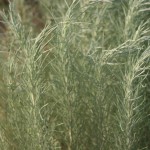Sand Sagebrush
Artemisia filifolia Torr.
Asteraceae (Sunflower Family)
Description
A small rounded to sprawling shrub with a woody base in the Sunflower family, Sand Sagebrush usually grows less than 13 ft or 4 m tall. Its most distinguishing features are its filiform leaves and faintly aromatic scent. Young stems are reddish brown changing to silver-gray in the upper areas. Mature stems are slender, dark gray to black, and covered with fine, short hair. Its bark often peels in narrow strips about 0.5 cm wide to 8 cm long. Its upper leaves are simple lance-shaped while its lower leaves are often three-lobed. The leaves are alternate and/or fascicled, slender (usually < 1 mm), up to 8 cm long, and light green. The flowers occur in dense, leafy plume-like heads measuring 8-15 cm by 2-5 cm. Flowering time is usually late summer to early fall. The fruit is small, dry, hard, hairless, and one-seeded; it does not open at maturity. Sand Sagebrush can grow in densities high enough to retard grass growth. The plant has low forage value for livestock, cattle only eat it when choices are limited or drought conditions are present. It provides fair value for wildlife by creating habitats for many animals. Sand Sagebrush is an effective erosion preventer for sandy soils.Habitat
Sand Sagebrush is an abundant native of dunes, sandhills, and deep sandy soils. It can reach altitudes of 6,000 feet or 1,830 m. It often grows in association with species of Yucca, Cactaceae, Salvia dorrii, and Sand Dropseed as well as in pure stands. It is a dominant species across much of the west increasing with over-grazing and even resprouting vigorously after a fire.Images
Plant Characteristics
Flower Color: White
Seed Type: Achene
Duration: Perennial
Stem Texture: Hairy
Growth Habit: Forbs/Broadleaf
Leaf Shape
 : Simple with Pinnate or Parallel Venation
: Simple with Pinnate or Parallel Venation
Season: Warm
Distribution
 : 07 - Edwards Plateau, 08 - Rolling Plains, 09 - High Plains, 10 - Trans-Pecos
: 07 - Edwards Plateau, 08 - Rolling Plains, 09 - High Plains, 10 - Trans-Pecos
Distributions
Distribution refers to the ecological region in Texas that a plant has been found. You can also view a clickable map.
Book: Brush and Weeds of Texas Rangelands (B-6208)
Collection: Brush and Weeds





